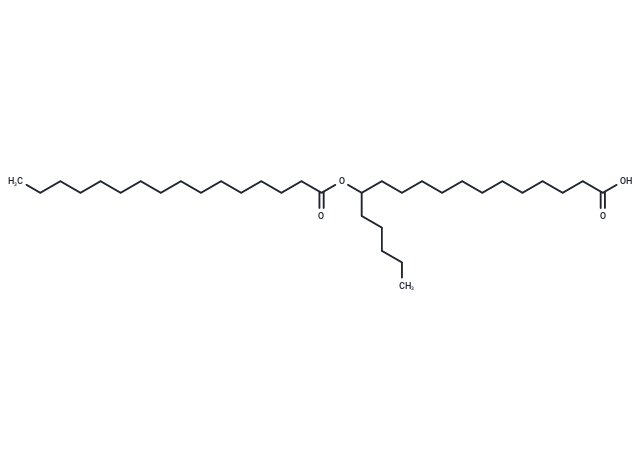- Remove All
 Your shopping cart is currently empty
Your shopping cart is currently empty
13-PAHSA
Branched fatty acid esters of hydroxy fatty acids (FAHFAs) are lipids influenced by dietary changes, playing a crucial role in insulin sensitivity. These compounds typically consist of a C-16 or C-18 fatty acid (for example, palmitoleic, palmitic, oleic, or stearic acid) linked to a hydroxy fatty acid with the same carbon chain length. 13-PAHSA, a derivative where palmitic acid is esterified to 13-hydroxy stearic acid, is notably prevalent in the adipose tissue of glucose-tolerant AG4OX mice, which exhibit enhanced glucose transport via the overexpression of the Glut4 glucose transporter. This observation, along with the metabolic benefits seen from other FAHFAs—including improved glucose tolerance, stimulated insulin secretion, and anti-inflammatory properties—suggests that 13-PAHSA may function as a bioactive lipid beneficial in managing metabolic syndrome and inflammation.

13-PAHSA
| Pack Size | Price | Availability | Quantity |
|---|---|---|---|
| 10 mg | Inquiry | 8-10 weeks | |
| 50 mg | Inquiry | 8-10 weeks |
Product Introduction
| Description | Branched fatty acid esters of hydroxy fatty acids (FAHFAs) are lipids influenced by dietary changes, playing a crucial role in insulin sensitivity. These compounds typically consist of a C-16 or C-18 fatty acid (for example, palmitoleic, palmitic, oleic, or stearic acid) linked to a hydroxy fatty acid with the same carbon chain length. 13-PAHSA, a derivative where palmitic acid is esterified to 13-hydroxy stearic acid, is notably prevalent in the adipose tissue of glucose-tolerant AG4OX mice, which exhibit enhanced glucose transport via the overexpression of the Glut4 glucose transporter. This observation, along with the metabolic benefits seen from other FAHFAs—including improved glucose tolerance, stimulated insulin secretion, and anti-inflammatory properties—suggests that 13-PAHSA may function as a bioactive lipid beneficial in managing metabolic syndrome and inflammation. |
| Molecular Weight | 538.9 |
| Formula | C34H66O4 |
| Cas No. | 2169306-42-5 |
| Storage | Powder: -20°C for 3 years | In solvent: -80°C for 1 year | Shipping with blue ice. |
Calculator
In Vivo Formulation Calculator (Clear solution)
Dose Conversion
Tech Support

Copyright © 2015-2025 TargetMol Chemicals Inc. All Rights Reserved.




